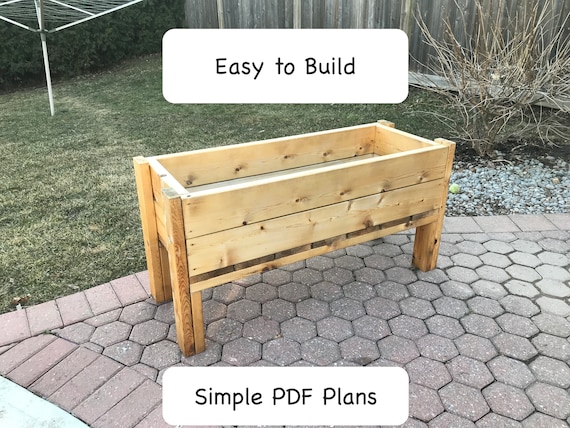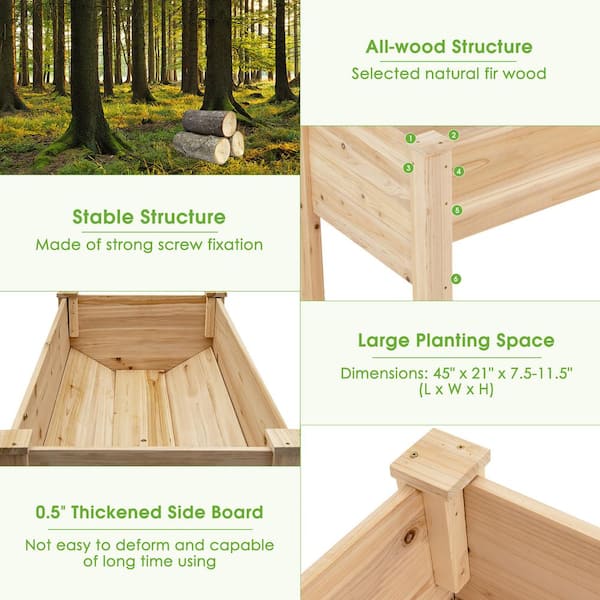Pallet wood raised garden bed plans provide a practical and affordable solution for creating a raised bed garden using recycled pallets as the main building material. These plans are ideal for homeowners who want to grow their vegetables or flowers but have limited space or resources.
You can avoid the cost and effort of buying and cutting new lumber by repurposing pallets. Pallet wood has a rustic charm that adds character to any garden. We will explore some simple pallet wood-raised garden bed plans that you can easily follow to start your DIY garden project.

Credit: www.etsy.com
Choosing And Preparing Pallet Wood
When building a raised garden bed with pallet wood, choosing the right pallets and preparing them properly is crucial. Pallet wood not only adds a rustic charm to your garden but is also an eco-friendly and cost-effective option. In this section, we will discuss selecting the right pallets and getting them ready for use.
Selecting The Right Pallets
Before you begin the project, selecting the right pallets for your raised garden bed. is important. Here are a few factors to consider:
- Type of pallet: Look for pallets that are made of untreated wood. Avoid pallets that have been chemically treated or have signs of mould or rot.
- Size and shape: Choose pallets that are in good condition and have sturdy boards. Make sure the size and shape of the pallets fit your desired garden bed dimensions.
- Origin: Ideally, opt for pallets that were used for non-toxic materials, such as food or beverages. Avoid pallets that may have been used for chemicals or hazardous materials.
Preparing The Pallets For Use
Once you select the right pallets, prepare them properly before using them for your garden bed. It is important to Follow these steps to ensure your pallets are safe and ready to use:
- Inspect the pallets: Check each pallet for any nails or screws sticking out, making sure to remove them to avoid injuries. Look for loose boards and secure them back into place.
- Clean the pallets: Brush the pallets with a stiff brush to remove air, dust, or debris. You can also use mild soap and water to remove stubborn stains.
- Sand the pallets: Use sandpaper to smooth the surface of the pallets, removing any rough edges or splinters. This step will help prevent any injuries when working with the wood.
- Treat the pallets (optional): If desired, apply a wood treatment product to protect them from weathering and extend their lifespan. Make sure to choose a non-toxic treatment suitable for outdoor use.
By selecting the right pallets and preparing them properly, you can ensure that your raised garden bed will be aesthetically pleasing and safe for your plants and the environment. Now that you know how to choose and prepare your pallet wood, it’s time to move on to the next step: constructing your raised garden bed.

Credit: www.homedepot.com
Building A Pallet Wood Raised Garden Bed
Planning The Size And Layout
Before starting the construction process, it is crucial to carefully plan the size and layout of your pallet wood-raised garden bed. First, consider the available space in your garden and the amount of sunlight it receives. You should also consider the types of plants you want to grow and their spatial requirements.
When determining the size of the garden bed, keep it no wider than 4 feet to ensure easy accessibility from all sides. Additionally, consider the height of the bed, aiming for a height of around 12 to 18 inches. This will allow for good soil drainage and root development.
Assembling The Garden Bed
Once you plan, gather your materials and assemble the pallet wood-raised garden bed. Begin by collecting enough pallets to match the dimensions of your desired bed. Make sure to choose high-quality, intact pallets free from chemicals or contaminants.
To start the assembly, lay a layer of landscape fabric or cardboard on the ground. This will help suppress weed growth and protect the soil from unwanted pests. Next, arrange the pallets in a rectangular shape, with the open sides facing upwards. Secure the corners of the pallets together using sturdy screws or nails, ensuring the structure is stable.
Adding additional support to the sides of the bed is advisable by attaching wooden stakes or corner brackets. This will further reinforce the structure and prevent wobbling or shifting over time. Be sure to fasten these supports securely, minimizing the risk of any potential accidents.
Adding Support And Reinforcements
Once the garden bed is assembled, it is important to add support and reinforcements to ensure its longevity and durability.
One effective method is to line the interior sides of the bed with landscape fabric or plastic sheeting. This acts as a barrier, preventing the soil from directly contacting the wood and causing it to decay. Additionally, this lining will help retain moisture in the soil, promoting healthy plant growth.
To further strengthen the construction, consider adding additional wooden planks or braces across the top of the pallets. This will add stability to the overall structure and prevent warping or bending of the wood.
Finally, fill the bed with high-quality soil or compost, ensuring it is evenly distributed. Your pallet wood-raised garden bed is ready to be planted with your favourite herbs, vegetables, or flowers, providing an aesthetically pleasing and eco-friendly gardening solution.
Maintaining And Caring For The Garden Bed
Learn how to maintain and care for your garden bed with these effective pallet wood-raised garden bed plans. Discover essential tips and techniques for maximizing your garden’s potential and ensuring its long-term health and beauty without any hassle.
Maintaining and Caring for the Garden Bed
WProper maintenance and care are essential foryour pallet wood raised garden bed,to ensure its longevity and the success of your plants. By protecting the wood from moisture and rot, managing weeds and soil, and following regular maintenance tips, you can create a thriving garden bed that will yield bountiful harvests for years.
Protecting the wood from moisture and rot:
To safeguard your pallet wood-raised garden bed from moisture and rot, it’s crucial to take preventative measures. You are applying sealant or paint to the bed’s exterior to create a protective barrier against water damage. MEnsureto focuses on the areas where the wood touches the soil, which is the most vulnerable to moisture. By sealing the wood, you prevent it from absorbing excessive water, which can lead to deterioration and rot over time. This simple step can significantly extend the lifespan of your garden bed.
Weeding and soil management:
An important aspect of maintaining a healthy garden bed is managing weeds and ensuring optimal soil conditions. Regular weeding is necessary to prevent unwanted plants from competing with your crops for nutrients and space. Regularly inspecting and removing any emerging weeds ensures that your plants can grow without hindrance. Additionally, maintaining a well-nourished soil structure is crucial for the health of your plants. Regularly enriching the soil with organic matter, such as compost or well-rotted manure, helps to promote fertility and proper drainage.
Regular maintenance tips:
Following some regular maintenance tips is important to keep your pallet wood-raised garden bed in top shape. Here are a few key practices to incorporate into your gardening routine:
1. Inspect the bed for any signs of damage or loose boards. Secure any loose pieces to prevent structural issues.
2. Reapply the waterproof sealant or paint every year or as needed to ensure the continued protection of the wood.
3. Periodically check for any signs of pests or diseases. Early detection and proper treatment can prevent the spread of infestations and infections.
4. Rotate your crops annually to minimize the risk of soil-borne diseases and pests. This practice helps to maintain a healthy and productive garden bed year after year.
Remember, caring for your pallet wood-raised garden bed is an ongoing process that requires attention and proactive measures. By protecting the wood from moisture and rot, managing weeds and soil, and following regular maintenance tips, you can create a thriving garden bed that will reward you with a fruitful harvest season after season.

Credit: homesteadandchill.com
Frequently Asked Questions Of Pallet Wood Raised Garden Bed Plans
How Do I Build A Raised Garden Bed With Pallet Wood?
Building a raised garden bed with pallet wood is a simple process. First, disassemble the pallets and remove any nails. Then, cut the pallet wood to the desired length and height for your garden bed. Next, assemble the pieces using screws or nails.
Finally, fill the bed with soil and plant your favourite vegetables or flowers.
What Are The Benefits Of Using Pallet Wood For A Raised Garden Bed?
Using pallet wood for a raised garden bed offers several benefits. First, pallet wood is a cost-effective option, as pallets can often be obtained for free or cheaply. Additionally, repurposing pallet wood is an environmentally friendly choice.
Lastly, pallet wood is durable and provides a rustic look to your garden bed.
How Do I Ensure The Safety Of Using Pallet Wood For A Raised Garden Bed?
To ensure the safety of using pallet wood for a raised garden bed, it’s important to choose pallets that are heat-treated (HT) or have a Food Safe Certification. This ensures that the wood is free from chemicals or contaminants. Sanding and sealing the wood can also help protect it and extend its lifespan.
Conclusion
To sum up, pallet wood-raised garden beds are a practical and budget-friendly addition to any garden. They not only provide a stylish and rustic appeal but also serve as an eco-friendly way to repurpose materials. Following the step-by-step plans outlined in this blog post, you can create your own raised garden bed and enjoy the benefits of growing your produce.
Start your gardening journey today and reap the rewards of a sustainable and beautiful garden space. Happy gardening!

